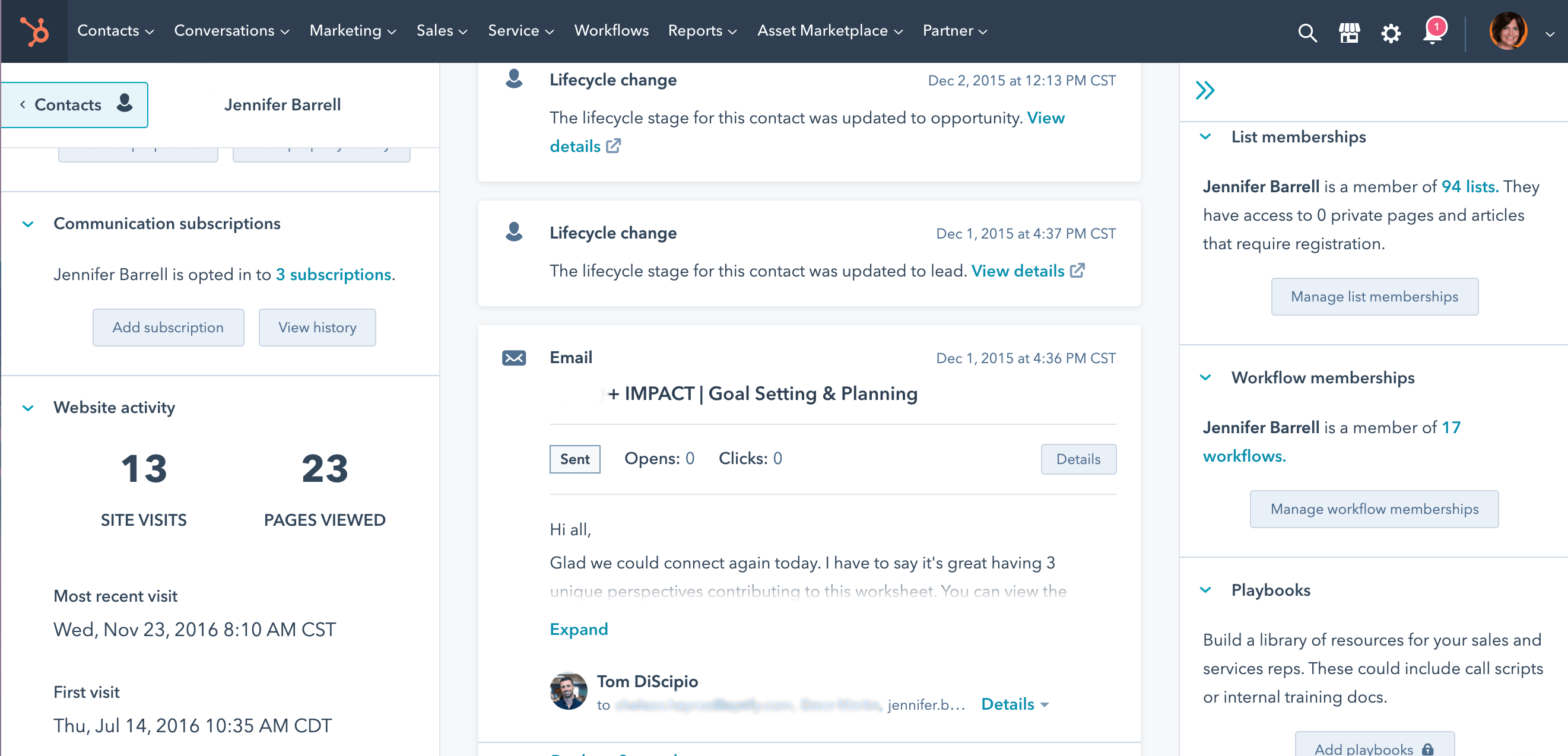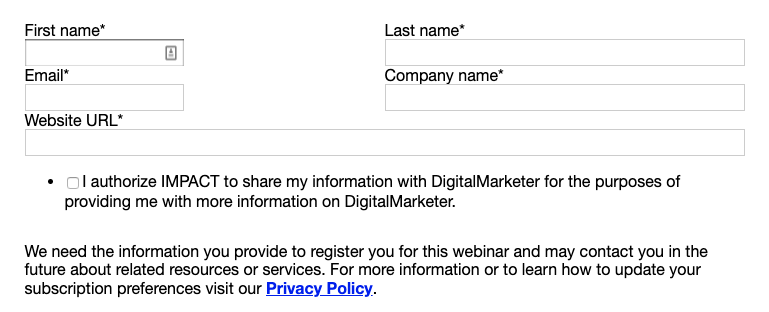Topics:
Search Engine OptimizationJoin 40,000+ sales and marketing pros who receive our weekly newsletter.
Get the most relevant, actionable digital sales and marketing insights you need to make smarter decisions faster... all in under five minutes.
What is intent data?
Also called predictive data, intent data is a collection of information that covers an individual’s online behavior. Marketers use this data to predict the likelihood of a specific person or organization’s intent to purchase a product.
Intent data.
These two seemingly innocuous words used to make me cringe.
I’d heard this buzz-y phrase for years and assumed, as most do, that it lived in the realm of quick-win marketing schemes, wherein companies pay for a list of maybe-but-probably-not interested prospects.
I didn't want to fall prey to yet another "tactic" that was really essentially another cheat with little to no pay-off. (Plus, we all know what "they" say about something that's too good to be true, right?)
But a deep-dive into intent data will show that sometimes those marketing trends, buzzwords, and hot topics really do live up to the hype.
Intent data in all of its versions, from data rendered from intent-based research to the lists data vendors produce and sell, can help us do our jobs better. It helps us produce content that keeps prospects engaged with us and, yes, it helps us create content that makes money — cha-ching!
As an inbound marketer and content marketing trainer, I’ve been using it — in fact, all of us marketers have been using it for years.
The fruit really is that sweet…if you know exactly what it is and how to use it.
What is intent data?
Also called predictive data, intent data is a collection of information that covers an individual’s online behavior. Marketers use this data to predict the likelihood of a specific person or organization’s intent to purchase a product.
Say, for example, that your marketing department wanted to start making in-house videos. A few people from your company, probably the marketing director and maybe an editorial assistant, might start searching for the type of video equipment they’d need to do this.
Their online searches would extend beyond a single website, of course. They’d most likely start with a search engine, which would lead them to an article, and then (hours later) they’d come up for air having navigated the wormhole of video equipment offers.
And they might do this for several days (or weeks or months) looking for the right products to buy, the right type of videos to produce, and the right video strategy to create.
Their intent data, then, would be composed of the entire width of their searches — everywhere they went, the time they spent exploring, the type of queries they entered, and the forms they filled out.
Can you imagine what that collection of information would be worth to video equipment manufacturers? To production companies? Or to video marketing companies?
Intent data became a marketing hot topic years ago, when data vendors started mining internet usage to pinpoint which organizations were most actively researching specific topics. The more research around a particular topic equates to a higher chance that a person is interested in buying.
And, of course, when you know someone is interested, you can specifically target them to get them to convert.
But the idea of getting out ahead of the buyer and nurturing them through the buyer’s journey obviously extends far beyond paid lists and information distributors. That’s just one part of the puzzle.
There are four types of intent data: first-party, second-party, third-party, and search.
What is first-party intent data?
First-party intent data is the type of information that most marketers are used to. This is data that measures engagement and is both anonymous and known.
If someone comes to your website and your marketing automation platform captures their IP address, you now have anonymous first-party data. In many cases, the IP address can be traced back to their organization, but they didn’t leave you a name so, yeah, they’re anonymous.
Then there’s known first-party data. As marketers, we use known first-party intent data every day. It’s really the backbone of digital marketing.
This is information gathered when someone fills out a form on your website. Once that form is filled out, your marketing automation platform keeps track of where that person goes throughout your site and how they engage with your brand.
The type of first-party intent data you can collect is broad and includes (but certainly isn’t limited to):
- Time on page
- Pages viewed
- Email opens
- Email click-throughs
- Offer downloads
- Events registered and attended

My HubSpot contact record from long before I was a glint in IMPACT’s eye.
Take a look at the contact record from back in the days before I came to work at IMPACT.
From this snippet of my record, you can see how many times I visited the website in a certain period, how many subscriptions I had opted into, The number of list memberships and workflows I was a part of, and any email communications I participated in.
As you can see, first-party intent data is a powerful resource, helping us create lead-scoring and nurturing campaigns. But how do you see what your prospects are doing when they’re not on your site?
That’s where the other three types of intent data come into play.
What is second-party intent data?
This information is similar to first-party intent data but is collected by another company and shared with or sold to you with the prospect’s permission.
Second-party intent data is commonly used by review and publisher sites but also includes marketing partnerships, like webinar attendees or event participation.
For example, let’s say you partner with another company to host a webinar. While you might be collecting the registrations, your partner will also want to know who attended so that they can communicate with attendees in the future.
It’s important to note that the prospect consents to their information being shared with another organization. This is what makes those checkboxes at the bottom of every online form so important.

When we co-hosted a webinar with our pals at DigitalMarker, we included a form that allows attendees to authorize information sharing. This is second-party intent data in action.
What is third-party intent data?
Even though intent data has a rather broad definition, it’s third-party intent data that often grabs the spotlight. In other words, this is what most people think of when the subject of intent data arises.
Third-party intent data is online engagement data that is mined and sold by information vendors like Bombora or intentdata.io.
Vendor companies will often partner with publisher sites to access the behavioral data of its users. Some companies, like Bombora, run data co-ops, where a network of publishers, tech providers, research firms, etc., pool data to gain better insights from all visitors across the co-op.
🔎 Related: Should you still be buying email marketing lists?
Still other data providers will run reverse IP lookups and mine advertising data to provide lists to their clients.
This is, of course, entirely legal.
When’s the last time you took the time to read someone else’s privacy policy?

The cookie notification from intentdata.io is quite obvious about sharing information with their partners.
Every time you accept that privacy policy pop up or cookie tracking notification, there’s a good chance you’re allowing that site to both track you and share your information with paying partners.
Intent search data
The final category of intent data comes through good, old-fashioned search engines.
How can we get in front of our prospects based on what they’re looking for? (Don’t overthink this — it isn’t a trick question.)
The answer is SEO.
Search engines provide an individual user answers to their query based on algorithms. As the world’s leading search engine, Google doesn’t reveal exactly how its algorithm works, but the SEO community believes there are more than 200 elements that work together to render Google’s search results.
While we may not know precisely how the algorithm works, we do know that search intent is tipping the scales, especially in the latest core algorithm update. Google’s algorithm is taking the searcher’s motivation into account and ranking pages higher based on how that page can answer the searcher’s intended question.
For example, I’ve been daydreaming about hitting the open road and getting a camper. (For those who don’t know me, it’s important that you know one thing about me: I. Don’t. Camp.)
It’s worth understanding that while I’m not a camper, I’m stir-crazy. I miss traveling. And I’m a sucker for good design. A well-designer camper might fit my needs.
More specifically, I’m driven by mid-century design. So, knowing that I want a camper with a more old-fashioned appearance, that’s what I enter into the search bar:

Notice how I searched for “old-fashioned campers” but the results don’t actually have “old-fashioned” anywhere on the page. Instead, the search has rendered “vintage” and “retro” — these are latent semantic index (LSI) keywords, keywords that Google believes to be closely related to my search.
The search engine knows that people who have searched for “old-fashioned camper” before tend to click on “vintage” and “retro” in the results. So it showed me what it thinks I intended to search for instead of what I actually searched.
That’s why it rendered images like this:

Retro, mod, and cute as a button!
And not this:

Yowza!
An intent-based research strategy, then, carefully considers the motivation behind an individual’s organic search, taking keyword research one step further.
It gives us more context into the searcher’s expectations, and it enables content marketers to provide the most relevant content, therefore reaching the most qualified readers and prospects.
Intent data vs. intent-based research
As we just discovered, intent data and intent-based research data really are part of the same family tree.
But while intent data covers a broad range of data mining, it is still primarily known as data that marketers and salespeople pay for to learn about digital behaviors.
Paid intent data pros and cons
Paid intent data provides a list of companies that contain individuals who have displayed high online engagement around a specific topic. For B2B organizations that have a robust sales team to target the entire list, this could prove to be a solid source of interested leads.
The downside is that paid intent data provides information at the account level and not on the individual. So your list will give you the names of interested organizations and then it’s up to you to find the right people within those companies that you need to communicate with.
This can be time-consuming and is another reason why such a list best fits with a larger sales team. Not everyone at the target company is a prospect, and there’s a possibility that no one is.
🔎 Related: Keyword research vs intent research, what's the difference?
Paid lists also decay quickly. There’s no guarantee that the person who was conducting a search within a company on your list will still be interested — or even employed at the same company — by the time you buy the list.
And, finally, the drawback of a paid list like this is that while there might be several people from the same target organization looking at making a purchase in your industry, the odds are low that they are the actual decision-makers.
Intent-based research pros and cons
Intent-based research, the research that provides us the intent search data discussed above, is much more direct and immediate, though it puts a higher workload on the marketing team.
An SEO strategy targets the individual performing a search. So it’s up to the marketers to 1) get their content to appear in the search results, 2) entice the searcher enough to click into the offer, and 3) fill out a form so that they become known.
While this can take time, you know that when that form is delivered, you have the data in real time. In other words, you know that the person who gave you their information is interested in what you offered them right now.
This tactic can either be free, if you stick to a purely organic SEO strategy, or end up costing more than paid intent data, depending on how much you spend on paid advertising.
How do you use intent data?
Once you collect your intent data, whether it’s from intent-based research, traditional digital marketing strategies, or paid lists, it’s time to put it to good use.
How you convert this data into marketing goodness is as varied as any of the digital strategies you employ. Here is just a taste of what’s possible with such data:
- Personalizing the user path on your website
- Developing lead scoring models
- Individualizing email workflows
- Building account-based marketing campaigns
- Creating targeted ads
So, does that mean intent data is the quick win of the beleaguered marketer’s dreams? Still no.
No matter what type of intent data you choose, there will always be skillful and time-intensive work required to turn it into happy, paying customers.
However, intent data can help us turn those sleepless nights panicking about where the leads will come from into productive time spent building strategies that will fill the pipeline.
Free: Assessment

